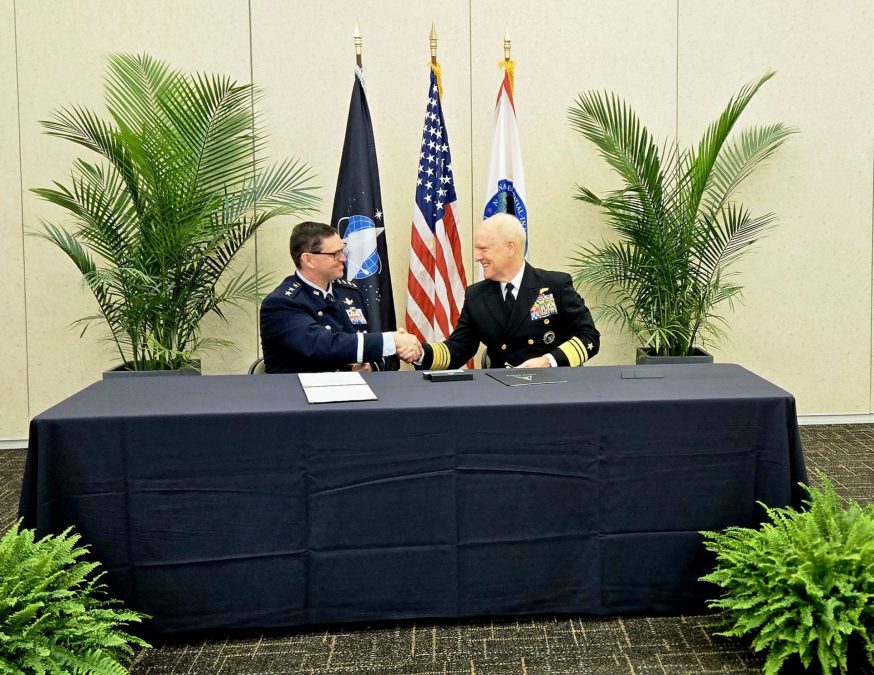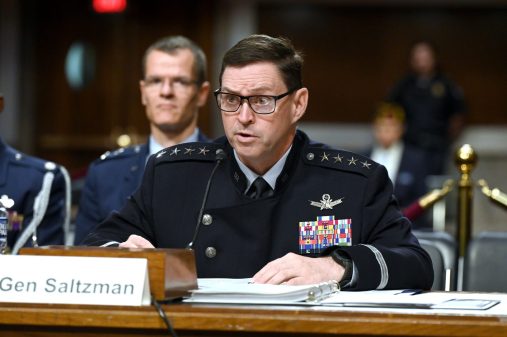Space Force, NGA reach agreement on purchasing power for commercial ISR

Top officials from the Space Force and the National Geospatial-Intelligence Agency signed a memorandum of agreement Wednesday that delineates how the organizations will share duties for buying space-based intelligence from commercial providers.
Inked by Chief of Space Operations Gen. Chance Saltzman and NGA Director Vice Adm. Frank Whitworth during the annual GEOINT Symposium in St. Louis, Missouri, the MOA outlines the boundaries between NGA’s operations and the Space Force’s nascent Tactical Surveillance, Reconnaissance and Tracking (TacSRT) program — putting an end to a two-year turf war over which organization should purchase commercial intelligence, surveillance and reconnaissance products and deliver them to combatant commanders.
“What [the agreement] really reflects is the quality of collaboration and every echelon that was necessary to work through these procedures,” Saltzman said in a statement. “I’m excited about this because of what it represents, and that’s really industrial strength collaboration.”
Whitworth first shared news of a drafted MOA with the Space Force in April during an interview with DefenseScoop, noting that moving forward NGA will work closely with the service to ensure the organizations weren’t “paying twice” for commercial ISR.
In a statement, Whitworth called the finalized agreement “a new standard for collaboration.”
While the full text of the MOA was not made public, the document outlines a “governance framework” between the intel agency and the Space Force by detailing the roles and responsibilities each organization has in providing commercial ISR to military leaders, an NGA spokesperson said in a statement to DefenseScoop.
Furthermore, a Space Force spokesperson told DefenseScoop that the MOA requires the service to collaborate with NGA support teams to “ensure data purchases and derived products … conform to consistent, mutually agreed upon National System for Geospatial Intelligence standards when applicable.”
The accord also states the Space Force will “coordinate processes and procedures for dissemination and releasability of products,” and submit a report to NGA each quarter that describes the service’s efforts to minimize overlapping efforts, the spokesperson added.
Disputes between the Space Force and NGA first arose when the service kicked off TacSRT in 2023. The program established a marketplace where combatant commanders can directly buy and rapidly receive “operational planning products” — including unclassified imagery and data analytics — from commercial space providers.
Although Space Force officials have touted the success of TacSRT and begun efforts to scale it, the program caused some tension between the service and the intelligence community.
Under current Pentagon-IC policies, NGA holds responsibility for acquiring commercial ISR products and determining who across the government receives them. At the same time, the National Reconnaissance Office is tasked with buying commercial remote sensing imaging and sharing it across the department and intelligence community.
Space Force leaders have claimed that TacSRT is not meant to step on the toes of NGA and NRO, but instead serve as a complement to the intelligence community’s work.
During a hearing with the Senate Armed Services Committee on Tuesday, Saltzman said the program “fills a niche where you have unclassified capabilities that can get quickly into planners’ hands.”
Now that the Space Force has finalized an agreement with NGA, the service is expected to also reach a similar arrangement with the NRO.
When asked by Sen. Kirsten Gillibrand, D-N.Y., about progress on the Space Force’s work with the intelligence agencies on Tuesday, Secretary of the Air Force Troy Meink emphasized that foundations for collaboration have been laid — but “the devil’s in the details.”
“We’re just starting to feel good now and starting to do experimentation with [TacSRT] now, using tools to allow that to happen,” Meink said. “There’s obviously still a lot of work to go, but I think there’s been great progress made, and the fact that we already have systems that we can start doing testing work and start doing exercise will be critically important.”






